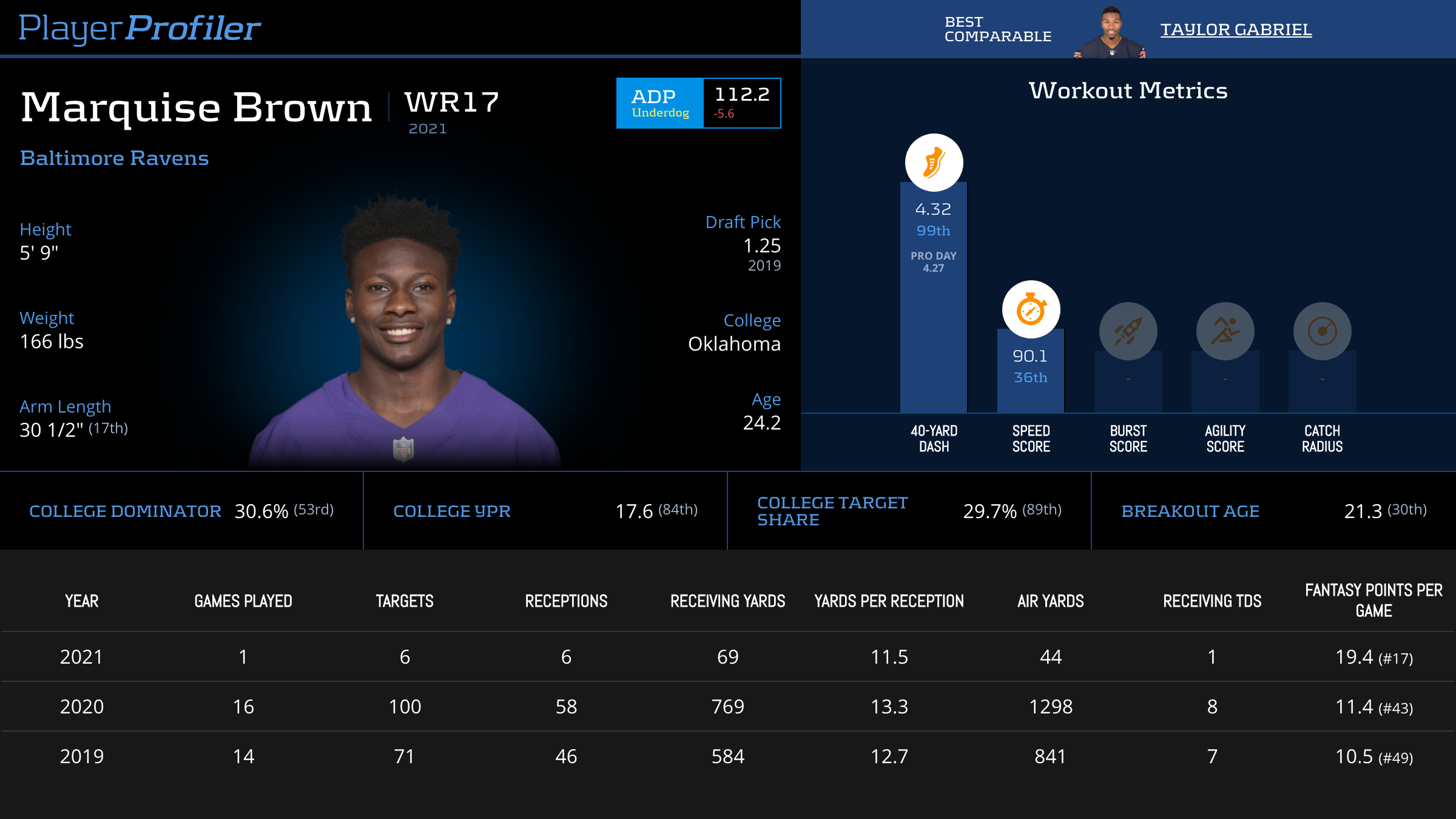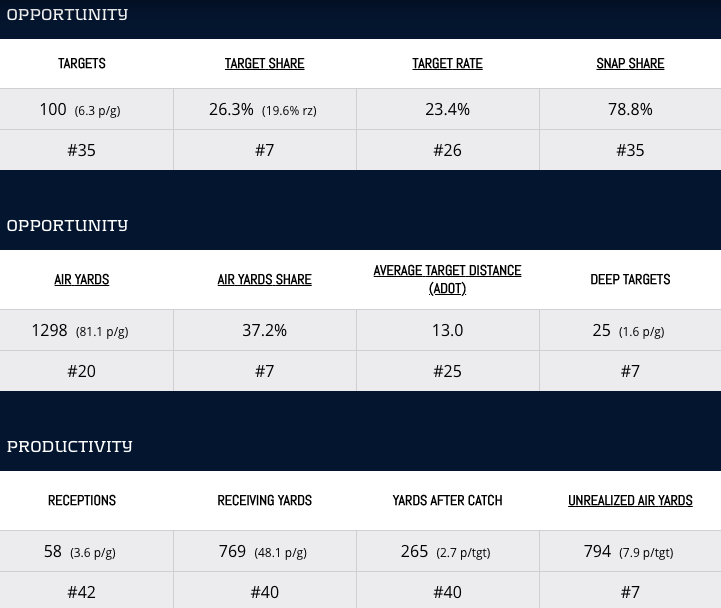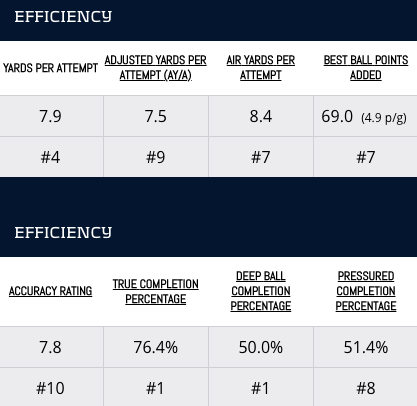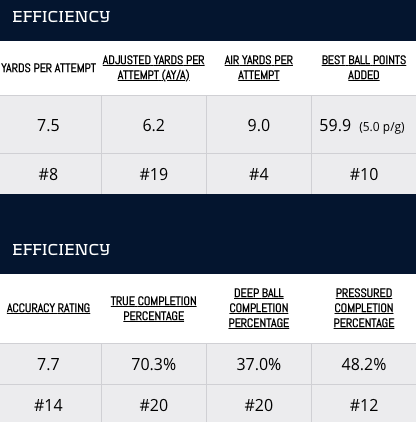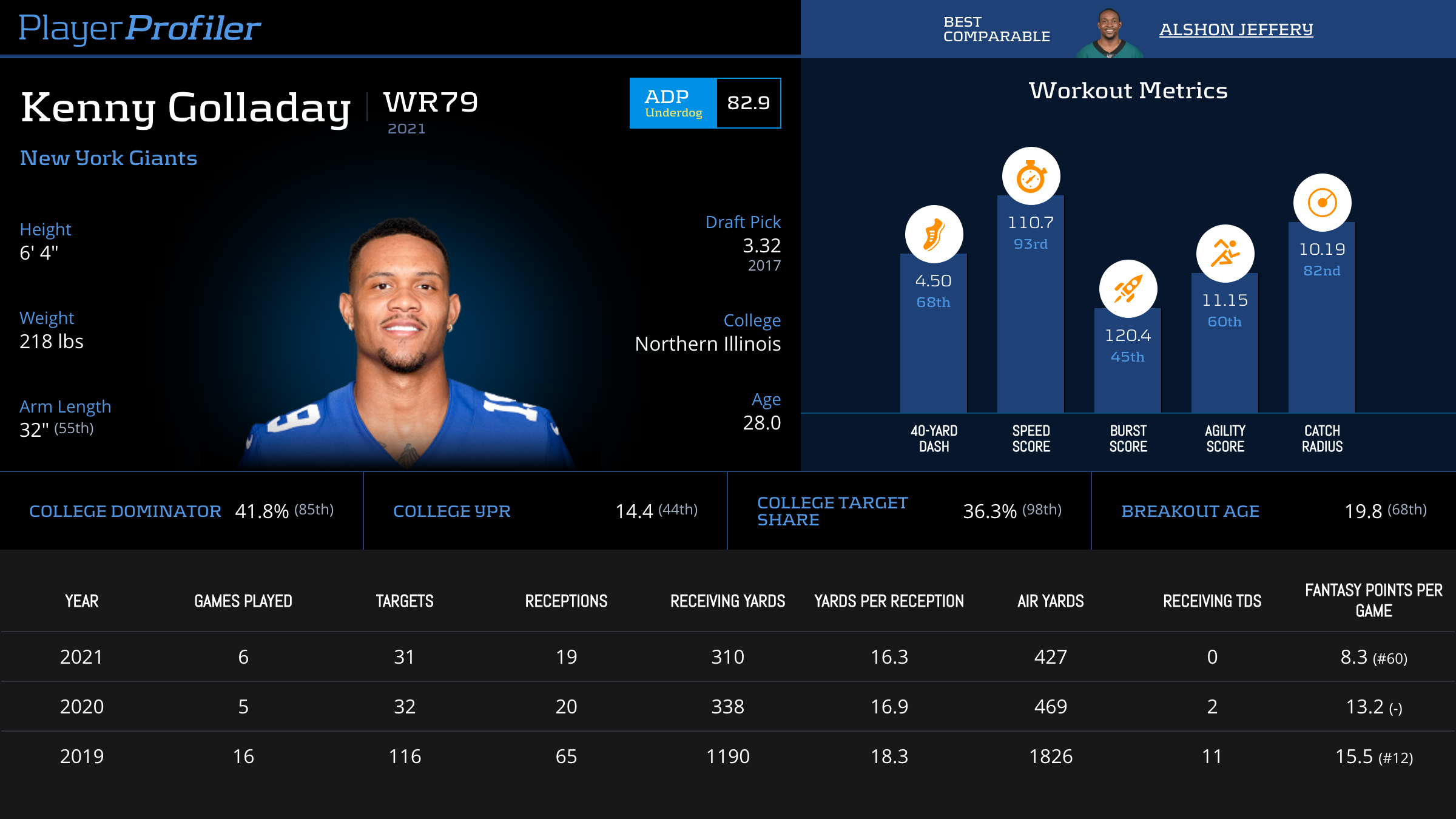Marquise Brown and Kenny Golladay fooled about every fantasy football manager in 2021. For the sake of being honest with ourselves and trying to improve our process, we’re taking a look at these two receivers – one stud and one dud – to determine what went wrong. In 2021, Golladay went into his first season with the New York Giants, and fantasy gamers drafted him as the WR29 in half-PPR leagues. No surprise here, but the former Lion will be representing our dud. Brown entered his third season with the Baltimore Ravens, and fantasy gamers drafted him as the WR57 – he’ll be our stud.
We want to focus on advanced statistics and metrics to look at what went right and what didn’t. Analyzing our past mistakes can help us become better fantasy football players. Ultimately, the most important thing is figuring out what each player can do for us this season. This is where it’s crucial to avoid holding grudges and getting too sucked into the whole “what have you done for me lately,” narrative because fantasy managers often have short memories. Let’s start with our stud, Marquise Brown.
Stud: Marquise Brown
There’s no denying that Brown had two different seasons in 2021. He had the Lamar Jackson experience and the Tyler Huntley one. Jackson played Weeks 1–13 before becoming injured in Week 14 and missed the rest of the season. With Jackson behind center, Brown dazzled. He scored enough fantasy points to be the WR12 in fantasy points per game in those first 13 weeks.
He averaged nine targets per game during that span, which tied for No. 9 among all receivers. The three-year pro posted top-12 numbers in several other telling metrics, cementing himself as one of the biggest steals of the 2021 season. He ranked No. 12 with 5.9 receptions per game, tied at No. 11 with 75 yards per game, and the No. 2 most air yards per game with 112. Brown’s 27-percent target share with Jackson at quarterback proved WR1 capabilities.
When Did You Know He Was One of Your Guys?
Prior to the 2021 season, several coaches for the Ravens talked about wanting to pass the ball more. After significantly leaning into their ground game in 2019 and 2020, and still getting bounced from the playoffs, the Ravens felt they needed a more diversified offense. Coaches and players said this repeatedly. Like all aspects of life – talk is cheap, but the Ravens went out and put actions behind their words when they drafted Rashod Bateman in the first round of the NFL Draft.
Baltimore drafting another receiver turned off most – evidenced by his WR57 ADP – but there were so many underlying metrics that shouldn’t have made fantasy managers nervous. In 2020, Brown had the No. 7-best target share among receivers at 26.3-percent. Unfortunately, this only resulted in Brown seeing 100 targets.
It’s not about just how many targets he received; Brown earned deep balls. He finished with 1,298 air yards despite just 100 targets. The former Sooner had the No. 7-most deep targets and unrealized air yards. The only thing stopping Brown from fully breaking out in 2020 was a low volume passing attack. If the team’s passing volume increased in 2021, Brown would reap the benefits. While you can never fully know if what coaches are telling us in the offseason is the truth, the price of admission to find out was so cheap it was more than worth it – low risk, high upside.
Why Did You Like Him So Much?
Fantasy football isn’t always easy, but sometimes we make it a lot more difficult than it has to be. Brown, for all of his perceived faults and regardless of the negative perception, entered the season as WR57. In hindsight, we all should have drafted Brown at that price. If one were to look at some of the other receivers around him, few were expected to be starting receivers. Even fewer were in line to catch passes from a former MVP.
The offseason is a time where NFL coaches talk – a lot. Reading through all of the junk is important, but in this case, when they talked about passing more, it all made sense. They were the best rushing team in football for two years – bounced in the playoffs both years. The Ravens needed more balance. They said it, repeatedly. The selection of Bateman only confirmed their commitment to passing more.
What Did You Learn?
One of the terms Brown often gets pigeonholed into is “boom or bust.” It turns fantasy managers away. It’s what has made Tyler Lockett a screaming value for years now. Everyone wants a consistent producer. If we want to be honest with ourselves, there aren’t very many of them at any position. So, if fantasy gamers can’t have consistency, why settle for boring? In this case, boring equals a player defined as having a healthy floor. What does that even mean? What does that mean for your starting lineup? Does this high floor player impact winning? The most likely answer is no. If the option is safe or boom or bust, give me boom or bust every time.
This is where Brown comes into play. Up until 2021, he embodied the definition of a boom or bust player with weeks where he was unusable. The problem wasn’t his boom or bust nature. The problem was the boom weeks didn’t happen enough to make up for the busted ones. How could that be rectified? Volume. More opportunities.
One of the things I learned is fantasy managers should embrace volatility. Players who can score 20+ points and play a pivotal role in winning a week are incredibly valuable. The eight-to-10-point scorers can be streamed and found on the waiver wire. A fantasy gamer needs to chase upside. Brown’s role as a down the field target sparked my interest. His was being targeted down the field, and he sported a healthy target share.
Where Would You Be Comfortable Drafting Him in 2022?
Brown’s situation changed this offseason when he was traded to the Arizona Cardinals, but it’s a positive change for his fantasy prospects. Since Kyler Murray and Jackson became starting quarterbacks, the Cardinals have been the more pass-heavy offense. 2021 favored Baltimore, but based on previous seasons and the injuries to its running back core, it appears to be more of an outlier than a true change in operating procedure. Trading Brown only seems to enforce that belief.
Kyler Murray vs Lamar Jackson
In that sense, Brown has a better chance of repeating his WR1 production in Arizona than he did in Baltimore. This is especially true based on Murray’s passing stats. The former No. 1 overall pick was the league’s best deep-ball passer in 2021 and ranked top-10 in yards per attempt and air yards per attempt. Comparing Murray to Jackson, as far as passing statistics go, showcases Brown’s opportunity to shine.
Whereas Murray ranked No. 1 in deep ball completion percentage, Jackson ranked No. 20. Murray had a significant statistical advantage over Jackson in accuracy rating and true completion percentage, as well.
In Baltimore, Brown was competing for targets with Mark Andrews. In Arizona, that’ll be DeAndre Hopkins, but the former Texan started to show some noticeable signs of decline last season. With Brown and Hopkins moving in opposite directions in regard to their career paths, it’s not unreasonable to expect Brown to be the 1A in Arizona. This discussion won’t even matter for the first six weeks of the season because Hopkins won’t be suiting up due to a suspension. During that time, Brown will be Murray’s unquestioned No. 1 target, and he should be valued as a top-12 receiver for the beginning portion of the season.
There were THREE WRs who had:
🔸️1500+ Air Yards
🔸️30%+ Air Yard Share
🔸️25%+ Target Share
🔸️140+ Targets
🔸️11+ Average Target DepthJustin Jefferson
Stefon Diggs
Marquise BrownTarget hogs that get loose downfield.
— Frank Ammirante (@FAmmiranteTFJ) June 3, 2022
Factoring in Brown’s more fantasy-friendly environment, and the upside he has early in the season without Hopkins, fantasy managers should be comfortable taking Brown around WR20.
Dud: Kenny Golladay
When the free agency dust settled, Kenny Golladay signed with the New York Giants. It wasn’t the greatest landing spot, unfortunately. Daniel Jones was fresh off a catastrophically bad second season where he finished with under 3,000 passing yards and just 11 touchdowns. Looking back at 2021’s offseason, there were several warning signs staring fantasy managers in the face. Still, it was difficult to have imagined a season quite as bad as the one the former Lion produced in 2021. Whenever a season goes that far south, there’s never only one reason for it. In Golladay’s case, this was certainly true. There were reasons upon reasons for why he became one of the biggest fantasy football busts last season. Let’s look at just how bad his 2021 season was.
His target share fell to 16.6-percent after not having been below 19.5-percent since his rookie season way back in 2017. That’s not the only area where his game fell off a cliff – his yard per route run average was 1.36, which was No. 79 among qualifying receivers. In 2020, his yard per route run average was 2.49 and in 2019, it was 2.35. In his second season (2018), Golladay averaged 2.18. Even in his rookie season, he averaged 1.71. 2021 represented some drastic declines in performance.
Needless to say, all of these performance reductions had a direct impact on his fantasy value. He averaged just 5.04 half-PPR points per game. In 14 contests, he provided fantasy managers with just a single game of double-digits. He finished with less than six points in nine games and had not one, but two goose eggs.
This won’t be a surprise to anyone, but the former Lion had zero touchdowns in 2021. His catch rate and his contested-catch percentage were all the lowest of his career. When you think about the “dud”, Golladay certainly fits the bill. By all accounts, 2021 was far and away his worst season in the NFL, which includes his rookie season.
When Did You Know He Was One of Your Guys?
There are plenty of hot takes that are made every offseason. Some are most certainly hotter than others, but maybe no hot take was hotter than Jones having a third-year breakout because of Golladay’s acquisition. This was a thing, and the comparison was Josh Allen.
But the simplified dots of Allen not being good in Years 1 and 2, which also happened to be true about Jones were connected. Then there was the bit of Allen getting Stefon Diggs and Jones getting Golladay, and the wheels were in motion. For the record, that was never the reason I liked Golladay.
The environment he was walking into wasn’t going to be ideal. Even the biggest Giants’ optimist knew expecting a significant leap in production was unlikely for the third-year signal-caller, but it couldn’t be any worse. The former Blue Devil did put together a competent rookie season with 3,027 yards and 24 touchdowns. That much was in his range of outcomes.
Then there were the “follow the money” taglines that were used to prop up Golladay’s fantasy value. The Giants wouldn’t have given him all that money if they didn’t intend to use him. In theory, that’s correct. Why spend money on something you don’t intend to use? This is where the real Golladay affection should have stemmed from. Looking at the Giants’ receiver depth chart showed a fairly easy path for the fifth-year player to become the most heavily targeted player and that holds value – even if the targets aren’t the most accurate. This was an exercise in chasing volume.
Why Did You Like Him So Much?
It’s hard to think of Golladay right now without making some kind of disgusted face. His name gets brought up on fantasy football Twitter, and it’s something reminiscent of the plague. Short-term memory is a mean, old trick.
The reality is Golladay had been an effective receiver since entering the NFL. In 2017, he was drafted in the third round and joined a receiving group of Golden Tate, Marvin Jones, and Eric Ebron. Both Jones and Tate went over 1,000 yards that season, but Golladay made his mark.
He finished with 477 yards and three touchdowns and averaged 17.0 yards per reception average. Golladay showcased his skill set as a deep ball threat. In Year 2, Golladay finished with 70 receptions, 1,063 yards, and five touchdowns en route to a WR21 finish in half-PPR scoring.
It was in his third season when the former Lion really broke out. He finished with 64 catches, 1,190 yards, and lead the entire league with 11 touchdowns. He finished the season as the No. 6 overall receiver in half-PPR.
After playing in 42 out of 48 games through three seasons, Golladay ended up only appearing in five games in 2020. He still averaged four catches and 68 yards per game. Over a 16-game season, he was on pace for 64 catches and 1,088 yards. Golladay had proven to be a solid fantasy asset, a WR2 player with upside. No matter what your short-term memory says about Golladay, from 2018–2020, he was a good, sometimes great fantasy asset.
What Did You Learn?
What to take away from Golladay’s failed 2021 season is difficult to answer. It’s hard to know how much each red flag played a role in one of the biggest busts of last year. How much fault does Jones carry? Or Jason Garrett or Golladay himself?
Following the 2020 season, the Giants ranked No. 31 in total offensive yards and points scored. They were No. 29 in passing yards and No. 31 in passing touchdowns. Jones, as already mentioned, didn’t even clear 3,000 yards and passing for just 12 touchdowns.
The 2020 season was the first year with Joe Judge as head coach and a season where Covid-19 significantly limited how much on-field practice time each team had. It was reasonable to expect growth in Year 2. Jones had also given us a glimmer of hope – a rookie season with a touchdown to interception ratio of 2:1 with 24 touchdowns.
Jones’ play in 2020 was atrocious, but we’ve seen receivers deliver quality fantasy seasons with bad quarterback play. It’s not even all that unfamiliar. Look at Brandin Cooks and Amon-Ra St. Brown last season or Terry McLaurin and D.J. Moore‘s entire careers.
I’m left wondering if the takeaway here is that there is no takeaway? Fantasy managers couldn’t have reasonably predicted the Giants’ offense to show zero improvements in Year 2 of Judge’s system. Just like it was equally unlikely Jones would be just as bad in 2021 as he was in 2020.
While Golladay played 14 games, it’s no mystery that he was hurt most weeks and never really was 100-percent. Injuries can’t be predicted. Everything that could go wrong for Golladay in 2021 went wrong. That’s an abnormality. It’s really no different when a player’s season goes perfectly, and we predict regression the following season because it’s incredibly rare to expect perfection to hit twice in consecutive seasons.
Where Would You Be Comfortable Drafting Him in 2022?
Golladay’s early-season ranking, and Underdog ADP are one of the more generous values for drafters during the beginning portion of draft season. He’s typically ranked right around WR55 and is currently being drafted as the WR57 on Underdog. It’s pretty rare to be able to draft a team’s No. 1 receiver that late in the draft. Sterling Shepard tore his Achilles late in 2021 and given his injury history, fantasy managers should be expecting him to miss a portion of the season. Kadarius Toney, while he impressed in short spurts as a rookie, was rumored to be on the chopping block this offseason. Evan Engram is gone, and while they did draft Wan’Dale Robinson, it’s reasonable to wonder how involved and effective a “5-8” rookie is going to be in Year 1.
Golladay doesn’t have a lot of target competition, and there’s a pathway to him having 115-125 targets per game. At his current cost of acquisition, all the risk is baked into the price – all you’re getting is the upside.
With a more competent coaching staff in Brian Daboll, it’s reasonable to expect marginal improvement on the offensive side of the ball. The Giants also drafted Evan Neal. He is no doubt an improvement to their offensive line.
They also brought in Tyrod Taylor, and there are a number of incentives in his contract. This could mean if Jones struggles, Taylor could start at quarterback. Either Jones takes a step forward and plays better, or he doesn’t and Tyrod becomes the starter. Either way, it all but guarantees he’s going to get better quarterback play.

